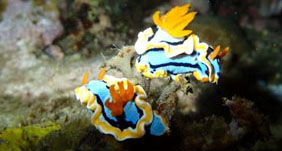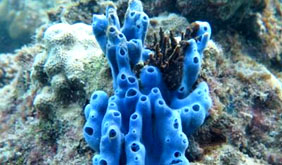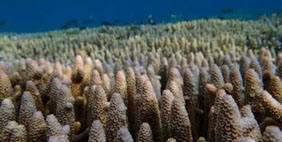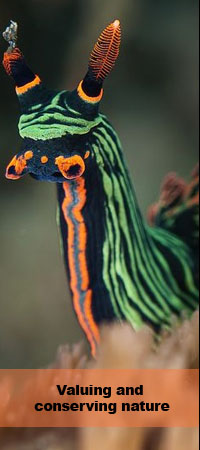|
Nudibranchs or sea -slugs occur throughout the world’s oceans and are present in many marine habitats up to 2,000 meters deep excluding tidal pools and estuaries. A large number of them are found in the Indo-Pacific and inhabit reef-building corals. Overall, habitat loss and degradation, pollution and overfishing represent the biggest threats to nudibranchs around the world. About 2,400 species are known to date.
Nudibranchs have given up the protection of a hard shell in their adult stage and instead they use other defense mechanism to protect their soft bodies. To avoid predators, they use camouflage, mimicry, chemical defense, and sometimes escape through poor swimming. Many species (e.g., Halgerda sp.) are difficult to find in their environment due to their great camouflage (color and shape). Others have a distinctive smell and taste as a protective mechanism. For example, the Sea Lemon Nudibranch (Anisodoris nobilis) from Western Canada and California has a citrus smell when it is handled. Nudibranch acquires often its color from what it eats. All known nudibranchs are carnivorous. Examples of their food include sponges, tunicates, barnacles, anemones, and many small organisms found in the ocean. They usually recognize their preys through two highly sensitive tentacles, called rhinophores, located on top of their heads. Their life spam can reach one year.
The number of threatened nudibranch species is unknown as their global assessment still remains to be conducted. However, our field observations over the years indicate that many species are becoming rare and more difficult to be found due to water pollution, degradation or loss of suitable marine habitats, and biodiversity decline. Tropical species of sea slugs that primarily feeds on tunicates (marine invertebrate animals) are heavily impacted by the decline of coral reefs where tunicates live.
Endangered Species International (ESI) deeply cares about all life on earth. We work hard to secure a future for all species, great or small, hovering on the brink of extinction. Our marine project sites have at least 160 inventoried species of incredible and beautiful nudibranchs. By creating and/or managing marine protected areas, ESI protects directly thousands of animal species including beautiful nudibranchs. The latter are an important part of the health of the marine ecosystem and local tourism activities. Our past surveys in the Philippines (2010-12) showed that most divers (70 percent) find nudibranchs as ones of the most fascinating marine creatures encountered during their dive.
Join us and support our work for endangered species and wild places. You are the source of our success — whether you renew your commitment annually, make a monthly sustaining gift or give to a special field conservation project.

|
|

A black nudibranch found in ESI marine protected area within the Coral Triangle (Southeast Asia). © Endangered Species International

Two colorful nudibranchs observed by ESI biologists in the Coral Triangle. © Endangered Species International

Nudibranchs feed on sponges like this blue sponge. © Endangered Species International

Coral reefs provide a vital habitat for many nudibranch species. © Endangered Species International
|









